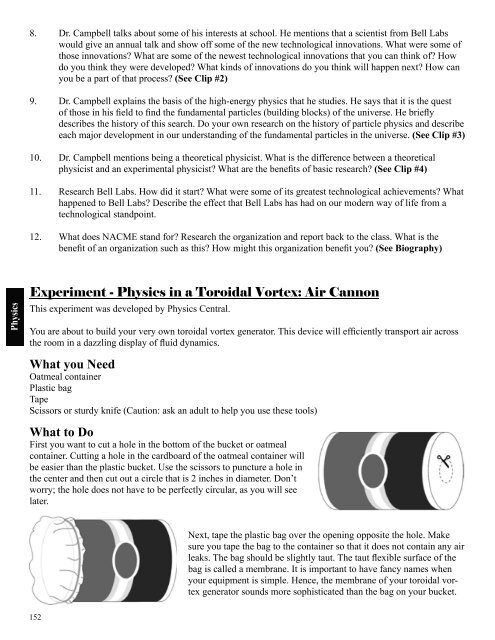ScienceMakers Toolkit Manual - The History Makers
ScienceMakers Toolkit Manual - The History Makers
ScienceMakers Toolkit Manual - The History Makers
Create successful ePaper yourself
Turn your PDF publications into a flip-book with our unique Google optimized e-Paper software.
Physics<br />
8. Dr. Campbell talks about some of his interests at school. He mentions that a scientist from Bell Labs<br />
would give an annual talk and show off some of the new technological innovations. What were some of<br />
those innovations? What are some of the newest technological innovations that you can think of? How<br />
do you think they were developed? What kinds of innovations do you think will happen next? How can<br />
you be a part of that process? (See Clip #2)<br />
9. Dr. Campbell explains the basis of the high-energy physics that he studies. He says that it is the quest<br />
of those in his fi eld to fi nd the fundamental particles (building blocks) of the universe. He briefl y<br />
describes the history of this search. Do your own research on the history of particle physics and describe<br />
each major development in our understanding of the fundamental particles in the universe. (See Clip #3)<br />
10. Dr. Campbell mentions being a theoretical physicist. What is the difference between a theoretical<br />
physicist and an experimental physicist? What are the benefi ts of basic research? (See Clip #4)<br />
11. Research Bell Labs. How did it start? What were some of its greatest technological achievements? What<br />
happened to Bell Labs? Describe the effect that Bell Labs has had on our modern way of life from a<br />
technological standpoint.<br />
12. What does NACME stand for? Research the organization and report back to the class. What is the<br />
benefi t of an organization such as this? How might this organization benefi t you? (See Biography)<br />
Experiment - Physics in a Toroidal Vortex: Air Cannon<br />
This experiment was developed by Physics Central.<br />
You are about to build your very own toroidal vortex generator. This device will effi ciently transport air across<br />
the room in a dazzling display of fl uid dynamics.<br />
What you Need<br />
Oatmeal container<br />
Plastic bag<br />
Tape<br />
Scissors or sturdy knife (Caution: ask an adult to help you use these tools)<br />
What to Do<br />
First you want to cut a hole in the bottom of the bucket or oatmeal<br />
container. Cutting a hole in the cardboard of the oatmeal container will<br />
be easier than the plastic bucket. Use the scissors to puncture a hole in<br />
the center and then cut out a circle that is 2 inches in diameter. Don’t<br />
worry; the hole does not have to be perfectly circular, as you will see<br />
later.<br />
152<br />
Next, tape the plastic bag over the opening opposite the hole. Make<br />
sure you tape the bag to the container so that it does not contain any air<br />
leaks. <strong>The</strong> bag should be slightly taut. <strong>The</strong> taut fl exible surface of the<br />
bag is called a membrane. It is important to have fancy names when<br />
your equipment is simple. Hence, the membrane of your toroidal vortex<br />
generator sounds more sophisticated than the bag on your bucket.










